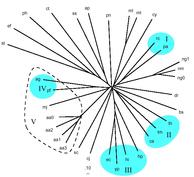Highlights of our Work
2025 | 2024 | 2023 | 2022 | 2021 | 2020 | 2019 | 2018 | 2017 | 2016 | 2015 | 2014 | 2013 | 2012 | 2011 | 2010 | 2009 | 2008 | 2007 | 2006 | 2005 | 2004 | 2003 | 2002 | 2001
Organisms evolve according to the Darwinian principle by optimizing their traits through mutations of their genomes. In the past this principle had been rather narrowly applied to single genes and the associated single proteins. Knowledge of the sequences of the entire genomes of organisms encourages today a broader perspective: evolution should improve the entire context in which proteins function in organisms, for example, entire metabolic or signaling pathways. A new method describing the tree of evolution of organisms includes accordingly entire groups of genes that consolidate a cellular reaction network. The new phylogenetic analysis of metabolic networks has been applied in a recent publication to electron-transfer and amino acid biosynthesis networks yielding a more comprehensive understanding of similarities and differences between organisms.




